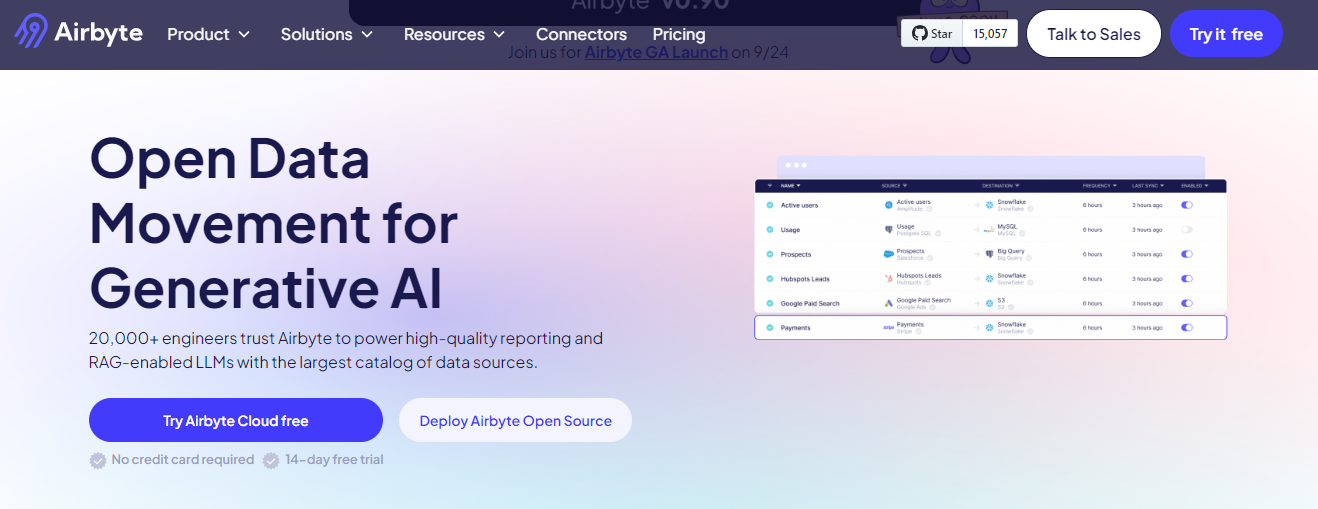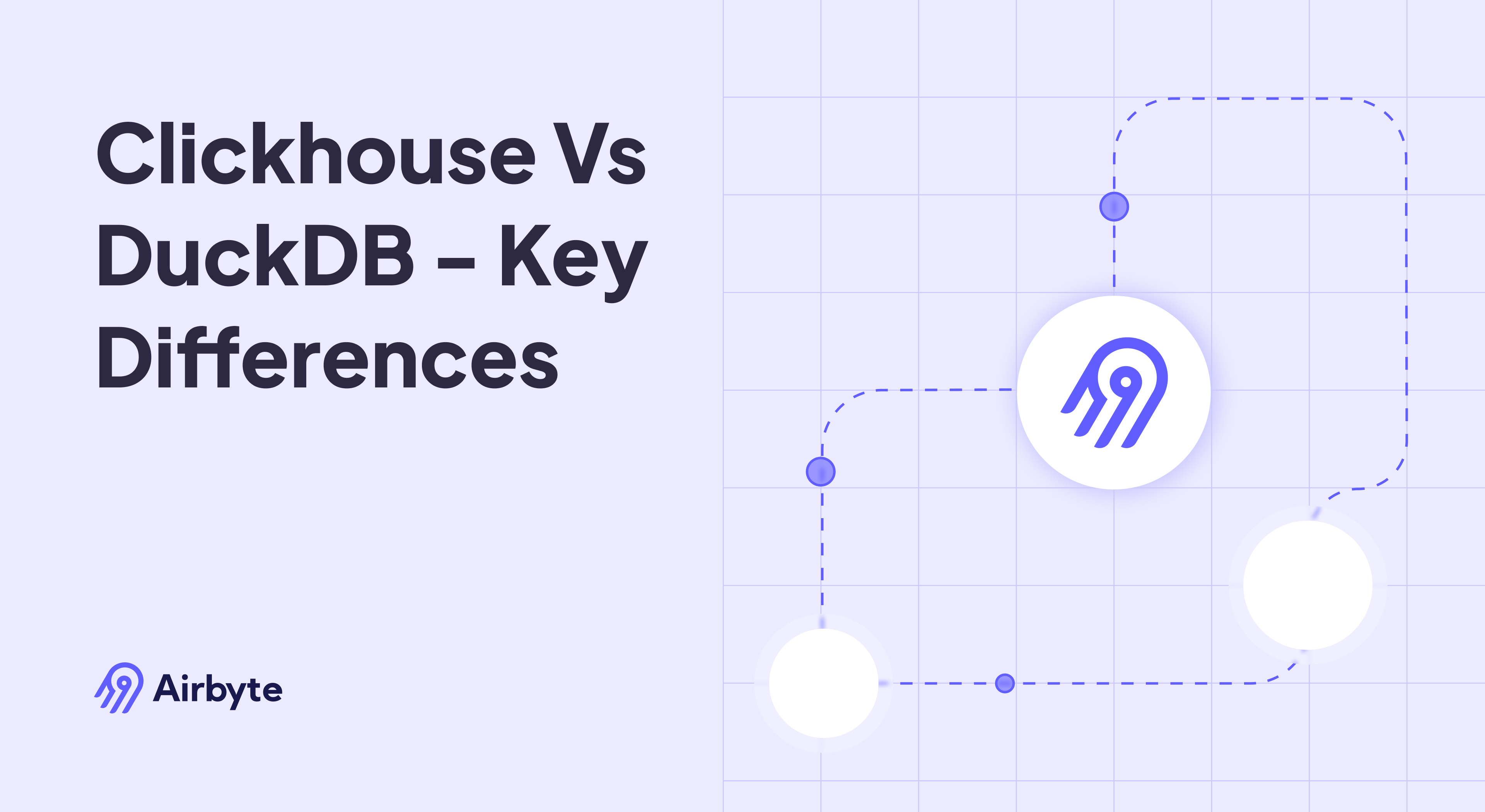ClickHouse vs DuckDB- Key Differences
Summarize this article with:
✨ AI Generated Summary
ClickHouse and DuckDB are both columnar OLAP databases optimized for analytics but differ in architecture and use cases:
- ClickHouse is a distributed, server-based system ideal for large-scale, real-time analytics with advanced compression, vectorized execution, and partitioning.
- DuckDB is an embedded, serverless database suited for in-process analytics on smaller datasets, offering full ACID compliance, extensibility, and high portability.
- ClickHouse requires external server management and offers paid cloud plans, while DuckDB is free, open-source, and easily integrated into applications.
- Data integration tools like Airbyte simplify syncing and transforming data across both databases, aiding in flexible deployment choices.
Multiple organizations continue to rely on relational database management systems (RDBMS) such as MySQL, Oracle, and SQL Server. While these systems perform well in certain scenarios, they often fall short with high-speed analytics.
For faster online analytical processing using SQL queries, ClickHouse and DuckDB databases are great alternatives. According to StackOverflow Survey 2024, 1.7% of developers prefer ClickHouse, and 1.4% use DuckDB. Although these database systems have smaller user bases compared to more popular RDBMS, they offer powerful features to enhance the utilization of your operational datasets.
This article will provide you with several ClickHouse vs DuckDB differences, helping you choose the one that is most suitable for your needs.
ClickHouse: A Brief Overview

ClickHouse is a column-oriented database management system primarily used for online analytical processing (OLAP) of large datasets. Unlike traditional row-based databases, you store ClickHouse data in columns. This enables efficient real-time analytical reporting using SQL-like queries.
A prominent capability of ClickHouse is its attention to low-level details, which is essential for building a high-performance OLAP database. This capability enables you to experiment with several optimized implementations that help you process queries quickly. You can then choose the most efficient one that balances minimal resource usage with maximum speed.
Key Features of ClickHouse
- Data Compression: ClickHouse supports general data compression modes such as LZ4 (default), LZ4HC, ZSTD, ZSTD_QAT, and DEFLATE_QPL. It helps you reduce storage requirements, minimize I/O and CPU usage, and accelerate query execution. ClickHouse also offers specialized codecs for specific data types, including Delta, GCD, Gorilla, and more.
- Disk Data Storage: Rather than depending only on RAM and SSDs, ClickHouse is optimized to operate efficiently on standard hard drives. This makes it more cost-effective in terms of storage costs per GB.
- Vectorized Query Execution: During query execution, ClickHouse uses a vector computation engine that enables you to process data on vectors, which are groups of columns. This improves CPU efficiency and minimizes the overall data processing cost.
- Quick Data Insertion: ClickHouse supports the MergeTree table engine, which is its core data storage capability. This table engine allows you to continually insert data into the MergeTree table while subsequent background data processing occurs.
DuckDB: A Brief Overview

DuckDB is a table-oriented, SQL-based OLAP database management system that facilitates efficient large-scale data analytics. To support these huge analytical workloads, it features a columnar-vectorized query execution engine. This vectorized engine enables you to process large batches of values, known as vectors, in a single operation.
DuckDB adopts SQLite's simplicity and embedded nature. As a result, DuckDB does not have any external dependencies during compile time or runtime. Like SQLite, DuckDB operates without needing separate server software to install, upgrade, and maintain. This serverless capability ensures efficient data integration and high-speed analytics.
Key Features of DuckDB
- Extensibility: DuckDB helps you dynamically extend its functionality by adding new data types, file formats, and domain-specific functionality.
- High Portability: DuckDB is compatible with all popular operating systems, including Windows, Linux, and macOS, as well as different CPU architectures, such as x86 and ARM. You can deploy it on small, resource-limited edge devices or large servers with terabytes of memory and over 100 CPU cores.
- Bulk Data Loading: You can bulk load CSV, JSON, or Parquet data into a DuckDB database instance using Appender. It is an efficient way to load data into DuckDB from within the C interface.
- Lightweight Data Compression: DuckDB supports multiple lightweight compression algorithms, including constant encoding, run-length encoding, bit packing, chimp, and dictionary encoding. You can also use the PRAGMA storage_info statement to inspect the compression techniques that DuckDB has applied to the columns of a table.
ClickHouse vs DuckDB: A Quick Tabular Comparison
The main difference between ClickHouse and DuckDB is that ClickHouse is a distributed, columnar database optimized for high-performance analytics on large-scale datasets, while DuckDB is an embedded, in-process database designed for fast analytical queries on smaller datasets within applications.
Factors to Consider When Choosing DuckDB vs ClickHouse
From storage architecture and indexes to query interface and pricing, here are the different factors that can help you choose between ClickHouse and DuckDB:
Storage Architecture
ClickHouse is an in-memory, disk-based database that uses different types of table engines, including MergeTree, Log, Integration, and Special. These engines help you determine where and how the data is stored, whether indexes are used, what types of queries are supported, and more. MergeTree is the core table engine used in ClickHouse to process large data volumes and support data replication and partitioning.
In contrast, DuckDB enables you to create persistent database storage to keep all the database objects, such as tables, views, or indexes, in a single file. Similar to ClickHouse, DuckDB also supports in-memory mode; the data doesn’t persist to disk and is lost once the process terminates.
Indexes
ClickHouse has sparse primary indexes, which allow you to physically sort the data based on the primary key and access it in milliseconds. It also supports secondary data-skipping indexes that help you skip data parts that won’t match query filter conditions.
Conversely, DuckDB uses min-max and adaptive radix tree (ART) indexes to speed up query execution. A min-max index is automatically generated for columns of general-purpose data types, including DOUBLE, FLOAT, INTEGER, etc. On the other hand, ART indexes are automatically created for columns with PRIMARY KEY or UNIQUE constraints.
Transactional Support
ClickHouse does not provide the full transactional support needed to update or delete data in a multi-user environment. To manage this limitation, you must develop custom transaction management solutions using external tools or implement batch processing techniques. These alternatives can help ensure data consistency within the ClickHouse database despite the lack of native transaction support.
Contrarily, DuckDB offers comprehensive transaction support with full ACID compliance. This enables you to handle multiple operations within a single transaction block while ensuring data integrity across the database records. DuckDB ensures transactional integrity by implementing ACID properties through its custom Multi-Version Concurrency Control (MVCC) system. The MVCC approach allows you to manage multiple data versions in DuckDB for efficient and concurrent read and write operations.
Join Algorithms
By default, ClickHouse utilizes the hash join algorithm to help you combine data from multiple tables. However, if the right-hand side table is larger, then the join execution time might vary. To enhance performance, you can use parallel hash join, enabling you to generate multiple hash tables concurrently. This will accelerate the join process, but it requires more memory resources. Alternatively, the grace hash join would be a better choice to resolve the memory constraint issue associated with parallel hash join. It helps you temporarily store data on disk, effectively freeing up memory while maintaining the join performance.
On the other hand, DuckDB uses several basic algorithms, such as hash, sort-merge, and index join, to merge tables. You can also handle range queries within DuckDB with the support of interval encoding join (IEJoin). IEJoin uses min-max indexes to minimize the amount of data that needs to be scanned. If there are large tables that exceed in-memory capacities, it also supports the out-of-core hash join technique.
Query Interface
ClickHouse offers two parsers: a full SQL parser for executing all kinds of queries and a data format parser for running INSERT queries. It also provides various user interfaces like HTTP, TCP, and JDBC to help you perform analytical queries across different platforms.
In contrast, DuckDB provides APIs for numerous programming languages, including C, Python, and R. These APIs enable you to load data and execute your queries efficiently. DuckDB also supports flexible extension mechanisms, including SQLite extension, which allows you to query data directly from SQLite databases or move data from SQLite to DuckDB.
Pricing
ClickHouse offers a 30-day free trial and three pricing plans as follows:
- Development Plan: A development plan is suitable for smaller workloads. It offers up to 1 TB of storage at $35.33 per month and $0.2160 per compute unit per hour.
- Production Plan: The production plan allows you to manage production analytics with unlimited storage and a dedicated CPU. It will cost $47.08 per TB/month and $0.6894 per unit/hour.
- Dedicated Plan: This plan is designed for the most demanding workloads that require millisecond latency.
Contrarily, DuckDB is a free and open-source database system.
Seamlessly Integrate Your Data with ClickHouse or DuckDB Using Airbyte
With ClickHouse and DuckDB both offering strong analytical features, the choice can be a challenging one. Whether you opt for ClickHouse for its real-time analytical capabilities or DuckDB for its cost-efficiency, you must first integrate your data with the database. This can be difficult with a manual approach, especially if your data is dispersed across multiple sources or in different formats.
To address the challenge of integrating your disparate data sources, you can leverage data integration solutions like Airbyte. With over 400+ connectors, including support for ClickHouse and DuckDB, you can consolidate large volumes of data from any source to your chosen destination. You can also transfer data from ClickHouse to DuckDB if you find that DuckDB is suitable for your evolving needs.

Let’s explore some of the key features of Airbyte:
- Customized Connectors: Airbyte’s no-code connector builder and low-code Connector Development Kit allow you to build custom connectors in just minutes. This is helpful if you cannot find the one of your choice in Airbyte’s connector library.
- Schema Change Management: With Airbyte, you can mention how schema changes in the source must be handled for each connection. If you are a Cloud user, Airbyte facilitates checks for schema changes in the source system every 15 minutes. For Airbyte self-hosted, schema checks are at most every 24 hours.
- Efficient Transformation: With dbt Cloud integration, you can build and apply dbt transformations right after syncing data with Airbyte Cloud. This enables you to quickly transform your data into a consistent format suitable for further processing and analysis.
Conclusion
ClickHouse and DuckDB share some common features like compression algorithms, vectorized query execution, and columnar storage format. However, you have seen certain ClickHouse vs DuckDB differences in this comprehensive guide.
ClickHouse is a suitable choice if you require large-scale distributed data processing and real-time analytics. On the other hand, DuckDB is a better option for efficient in-memory analytics on smaller datasets and cost-efficiency. Your choice ultimately depends on your requirements and use case.

